Miscellaneous Facts About Transatlantic Travel - 1910
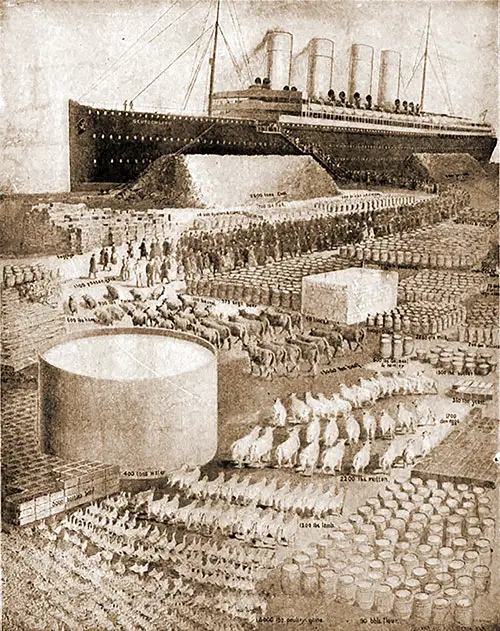
Graphic Representation of the Supplies Needed for a Transatlantic Voyage of the SS Deutschland of the Hamburg-American Line circa 1910. GGA Image ID # 17b90adf38
Typical Cargo Items on Large Express Steamship
The following are some of the cargo items on a large express steamer of 18,500 tons:
- Corn and wheat, 170,000 bushels
- Lubricating oil, 3,362 barrels
- Lard, 6,225 barrels and tubs
- Dried prunes, 11,625 boxes
- Cottonseed oil, 700 barrels
- Phonographs, 174 cases
- Type-writers, 73 cases
- Sewing-machine woodwork, 867 cases
- Agricultural implements, 3,219 packages
In all, 62 kinds of American products were loaded into this one vessel. After deducting the cabin space for 1,450 passengers of all classes and bunker space for 2,000 tons of coal, there remain 785,000 cubic feet for cargo.
If loaded exclusively with one kind of freight, it could carry any one of the following quantities:
- 590,000 bushels of wheat, or 628,000 of corn
- 31,000 bales of cotton, or 15,000 tons of copper
- 65,000 barrels of oil, or 825,000 boxes of dried fruit
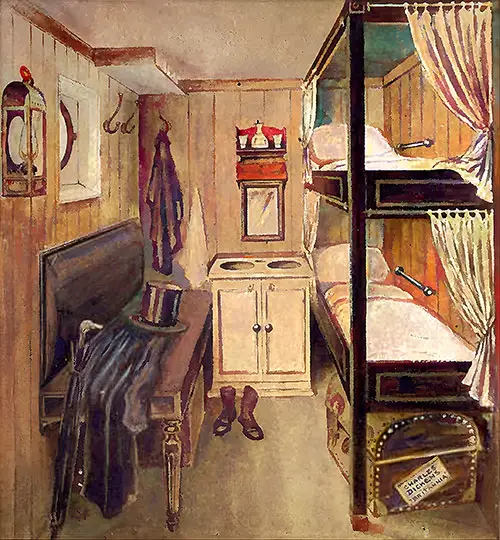
Illustration of the Cabin Occupied by Charles Dickens, Who Went to New York in the Cunard Steamer RMS Britannia in 1842, was Evidently not Enamoured of England's Premier Steamship Line. GGA Image ID # 17b918f0be
Past and Present Ocean Liner Travel
Those who wish to see the difference between the modern liner of today with its great luxury, and the vessel of sixty years ago, should read, while onboard, Charles Dickens' account of his early voyages to America which are given in "American Notes" and "Martin Chuzzlewit."
Keeping Eggs Fresh - An Unusual Manner
One steamship company keeps eggs fresh by covering them with fresh butter as soon as received, placing them on straw, and turning them every day.
Converting Foreign Currency
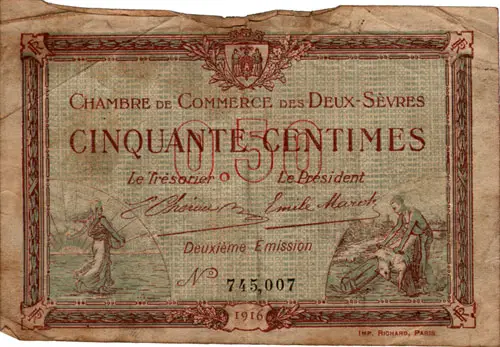
0.50 French Francs Note from 1916. GGA Image ID # 17bb183fba
Remember that the purser only carries a limited supply of foreign currency and can only exchange money for passengers to a limited amount. Do not calculate to do any more than paying your ship's account with steamship checks if you use them.
New Service Between Hamburg and New Orleans
A new service between New Orleans and Hamburg will become shortly be inaugurated by the Hamburg America Line. This will divert a portion of the immigration business into the Southern States; although the sea journey is considerably longer, the passenger rates will be the same.
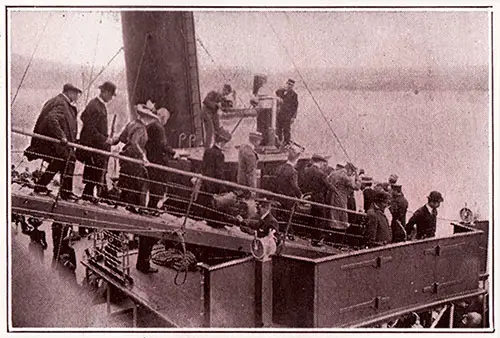
Passengers Disembark Onto Tender at Fishguard circa 1910. GGA Image ID # 17b9315f4f
New Piers and Breakwater at Fishguard
The piers and breakwater are being completed at Fishguard. This will enable ships to come alongside and embark passengers and mail on Saturday night instead of having to wait five or six hours at Queenstown.
Packages Delivered On Steamer
Baskets of fruit, boxes of books, as supplied by Brentano's, should reach the steamer in ample time before sailing—if possible the day before.
Flowers should reach the steamer an hour before sailing. Florists are used to this kind of trade and make all the arrangements with almost unerring success.
Passengers can have flowers kept in cold storage until the ship arrives. Liquors should not be sent as presents, as it is forbidden for passengers to supply their own liquors. The stateroom number should be put on all package labels.
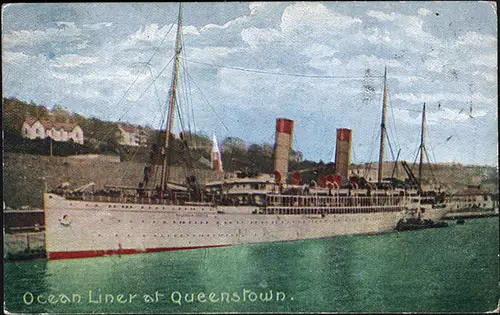
Ocean Liner at Queenstown, Colorized Photograph from Postcard. GGA Image ID # 17b93c2708
Cunard Line to Eliminate Queenstown (Cobh) as Port for Mail Ships
The Cunard Steamship Company has decided to eliminate Queenstown altogether as a port of call for their eastbound mail ships. The slower liners "Caronia" and "Carmania" will call at Queenstown on both their east and westbound trips in the summer.
By the saving of time in dropping Queenstown, it is expected that passengers from the " Mauretania" and " Lusitania" will reach London on Monday in time to connect with the nine o'clock mail train via Dover-Calais, which will land them in Paris at 5.50 a. m. Tuesday morning.
This will land passengers in Paris from eighteen to twenty-four hours earlier than by the present Cherbourg service. Special carriages for passengers to the Continent via the Great Western Railway will be slipped at Reading, thus cutting out London on Dover's trip.
Department Store
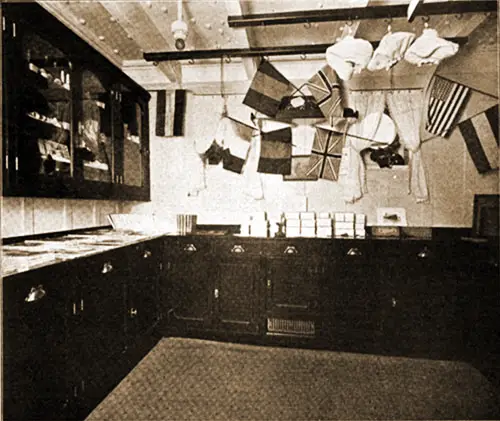
The Little Boutique Shop on Board the Steamship "Lapland" of the Red Star Line, 1909. Men's Wear, 5 May 1909. GGA Image ID # 15ea40a806
On one ship, at least, there is a "department store," so-called, although it is only a counter where notions and other articles needed by travelers are sold. Similar stalls should be on all ships, although the barber often supplies the minor necessaries of life.
Fresh Flowers
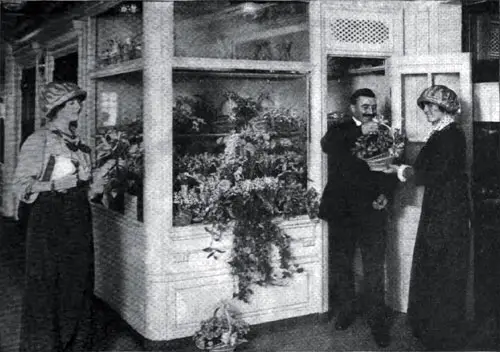
The Florist Shop on the SS Imperator, 1914. GGA Image ID # 17bb1248ea
A florist's shop is carried on one or two ships, ensuring fresh flowers during the voyage.
Fancy Work For Ladies
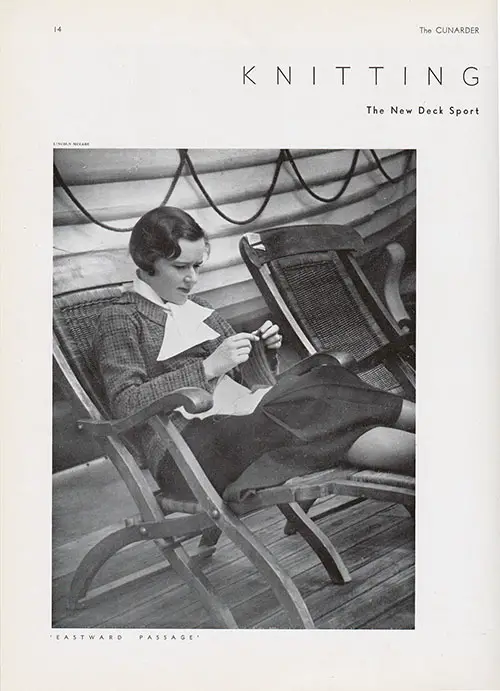
Young Woman Passenger Knits Away While Relaxing on a Deck Chair. GGA Image ID # 17baf3f361
Ladies will find a little fancy work will occupy spare moments, especially if the weather is so bad that the deck is not agreeable.
Drinking Water
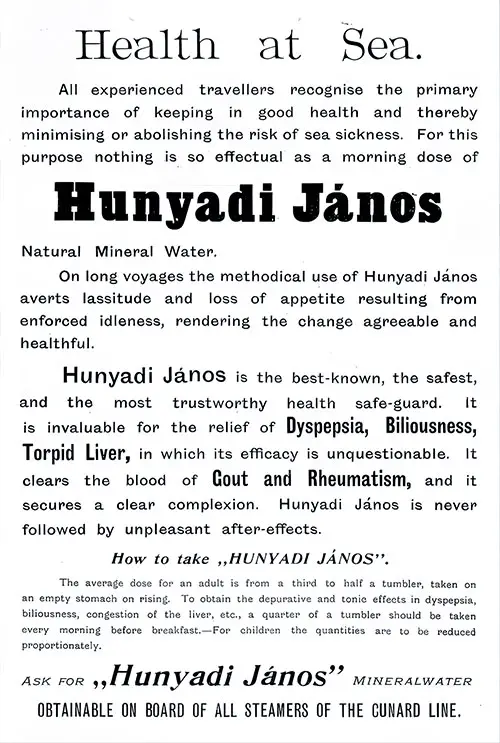
Advertisement for Hunyadi János Mineral Water, Cunard Daily Bulletin, Lusitania Edition, 6 June 1908. GGA Image ID # 17b961030b
The subject of drinking water is an important one. The water on the steamer is all right, but for the first few days after landing, the visitor should be cautious about drinking ordinary tap water at hotels, and particularly in stations.
Mineral water can be obtained everywhere and is very cheap. Ordinary carbonated water may be purchased or natural waters, such as Apollinaris or Perrier water.
In Germany, Rossbach water can usually be had as well as Rhen's water. In France, St. Galmier and Vichy (still) can be obtained. Tea, coffee, and chocolate also prevent the necessity of drinking ordinary water.
In England, beers, ales, and stout are cheap and good, while in Germany, beer, Rhine wine, and Moselle wine can be obtained everywhere. In France (outside of Paris), wine is good and cheap, while in Italy, the wipe is plentiful and very cheap.
Ice water is practically unknown except at the hotels where the trade of Americans is catered to; here, the waiters are apt to bring on ice water before service begins. In many places, as in Italy, there is a small charge made for a little plate of ice. The water of Venice is particularly vile and should be entirely eschewed.
Notification of Ships' Arrival at Destination
Persons who wish to be notified of a steamers' arrival can make arrangements with the two telegraph companies to inform them of the arrival.
The companies maintain signal stations at Fire Island, The Highlands, and Sandy Hook; also at Quarantine, to report steamers' sighting and arrival from foreign ports.
To those who live in New York or nearby towns and cities, one will receive the notice in ample time to reach the dock by the time the steamer warps in.
The service for New York, New Jersey, and Hoboken is $1.00. The companies can notify persons located elsewhere interested in incoming steamers by paying this fee of $1.00, plus the usual telegraph tolls for the ordinary ten-word message.
Of course, for places not adjacent to New York, the notice conveys the intelligence of the near approach of home-coming steamers, but hardly in time to enable the steamer to be met.
On March 5, 1910, the night letter service was inaugurated. The under-lying thought in establishing this service was to give the public the benefit of the unemployed wires at night to quicken correspondence at low rates to replace letters by mail.
The rates charged are the standard day rates for ten-word messages. For the transmission of fifty words or less plus one-fifth the initial for each additional ten words or less.
To be entitled to this rate, the message must be written in plain English language and destined for points where the telegraph companies have offices.
Code messages will be charged for at standard day or night rates as the case may be, and night letters will not be accepted for other line points.
Night letters will be accepted and collected on call in any hour of the day or night for delivery at destination on the morning of the next ensuing business day by mail or messenger. They will be transmitted at the company's convenience during the night.
The special form, known as "Form 22,89," should be used for writing the night letter. Night letters at the option of the telegraph company may be mailed to the destination of the addressee.
The company shall be deemed to have discharged its obligations in such cases concerning delivery by sending such night letters at the destination, postage prepaid.
By the time this book is in the reader's hands, the combined telegraph and telephone service will probably be in effect. The plan is to allow those telephone subscribers whose local telegraph office is closed for the night to call up central and send a telegraph message.
Central will transmit to the next telegraph office so that a telegram may be accepted from a telephone subscriber at any time during the twenty-four hours.
This may be modified in some manner when complete instructions are prepared, but this is about what the combined telegraph-telephone service will be.
Music Concerts
On many steamship lines, small string orchestras are carried, and their services are paid for by the company. Still, occasionally a plate is passed around by some of the passengers on the day before landing. On some of the German lines, there is a band, and passengers are expected to contribute to benefit a charity.
The offering is made when the steward collects the passengers' wine bills; the word music is printed across the statement's bottom. Nearly every steamer carries a piano that can be used by passengers.
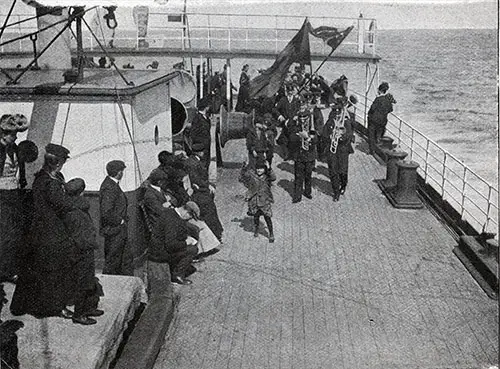
The Ships' Band Plays on the Aft Deck of the SS Scandinavia of the Scandinavian-American Line, 1912. GGA Image ID # 17bd9042b5
A contribution is often taken for the benefit of some seamen's charities. Programs (sixpence or a shilling) are sold for the same purpose. National anthems form a part of the program. And, regrettably, so few Americans have not more than a passing acquaintance with "America," or "The Star Spangled Banner." Coincidentally, an Englishman is sure to know "God Save the King" and "Rule Britannia."
To assist the memory, words and music of the National Anthems follow; versions vary considerably, particularly in the "Marseillaise," so the French words are also given.
The increasing shortness of voyages seems to be the cause of the decadence of the ship's concert. On German ships, the captain's dinner takes its place.
A winter garden is provided on one or two vessels, tastefully decorated with palms, tropical plants, and flowers, affording a most delightful resort for passengers who can listen to the orchestra.
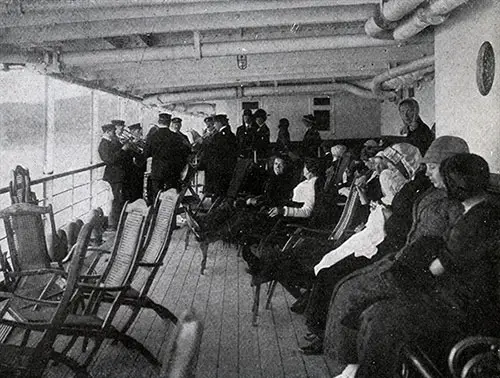
A Band Plays on the Second Cabin Promenade Deck on the SS Hellig Olav of the Scandinavian-American Line, 1917. GGA Image ID # 17bde94972
Ocean Stop-Over at Ports of Call
Passengers who wish to disembark at a port of call when the steamer is proceeding to other ports should notify the baggage master. If a baggage master is unavailable, the purser can retrieve and land the baggage. Stop-over privileges are usually allowed on steamships, and the purser can make the necessary arrangements. However, there can be no general rule.
Stop-overs afford opportunities for a side trip, and proceeding by subsequent voyages is often allowed. Passengers are not always required to book for an entire cruise, as one can make arrangements to return to your home port or tour other parts of Europe on other vessels of the same steamship line (or affiliated steamship lines).
Many World Cruises are set up so that fellow voyagers can call on many ports around the world, the larger ones, a stay of two days in port is not uncommon, while smaller ports may only have less than a day to see the local sites before moving on to the next port.
Pier Permits
It is a mistake to assume that your friends can come on to the pier to meet you on arrival in New York, although it is true that they can meet you at the exit of the pier.
To go on a pier and be present while the baggage is being examined requires a permit from the Port's Collector, countersigned by the Surveyor of the Port.
One can secure such permits by sending a letter to the Port's Collector stating the steamer's name and the probable date of arrival. Stamps should accompany this application.
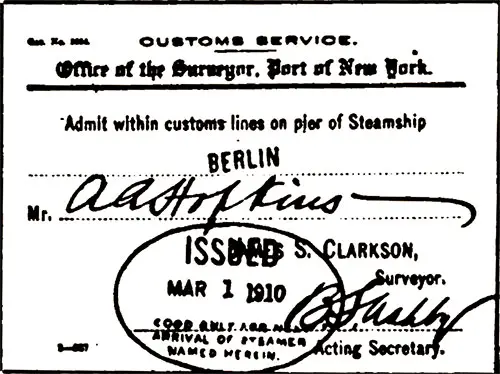
Facsimile of Pier Permit Issued by the New York Customs Service, Office of the Surveyor, Port of New York, Issued 1 March 1910. GGA Image ID # 17be2758ef
Applications may be made in person in Room 241, Customs House, Bowling Green. According to the rule, only two permits are given to meet each passenger. However, there is usually great latitude in the rule's enforcement. It is unlikely that an application will be refused.
Take no bags or parcels to the pier and stand clear when the inspectors are working on your friend's baggage. While it is quite a good deal of trouble to get one of these permits, the advantage of meeting dear friends fully an hour before they will see them otherwise always makes an effort worth the while.
Permits to meet the incoming vessel at Quarantine are given only in extreme cases. They should not be asked for except in such extraordinary emergencies such as fatal illness, etc.
Reading Matter - Books and Magazines
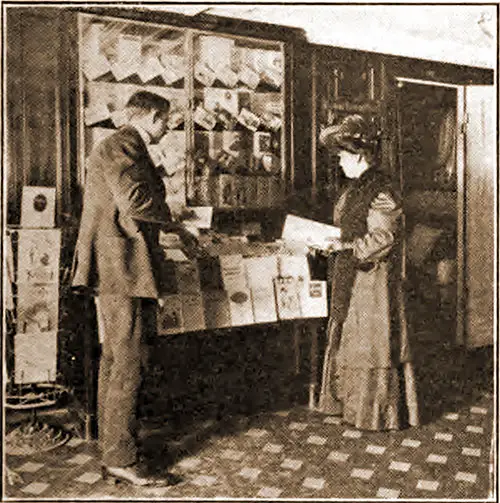
Passengers Peruse Literature at the Books and Brochures Kiosk on a Steamship. GGA Image ID # 17be6bef6e
There are bookstalls on certain ships where one can obtain works of fiction, travel guide books, and periodical literature. Such stands should be on every vessel. Periodicals are sold on the piers of all lines.
Every steamer carries a library for the free use of passengers. Books can be taken to staterooms but should be returned to the library steward before landing. Remember that he has to pay for all hooks lost. One will find the SCIENTIFIC AMERICAN in the reading rooms of 150 ocean and coastwise steamers and 250 library and Café cars on railways in the United States.
